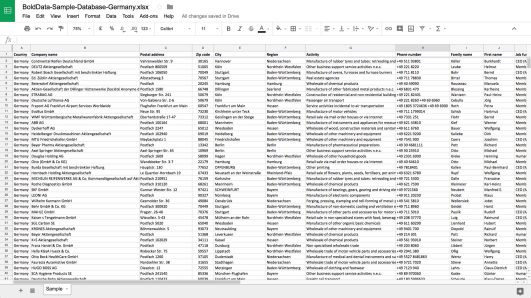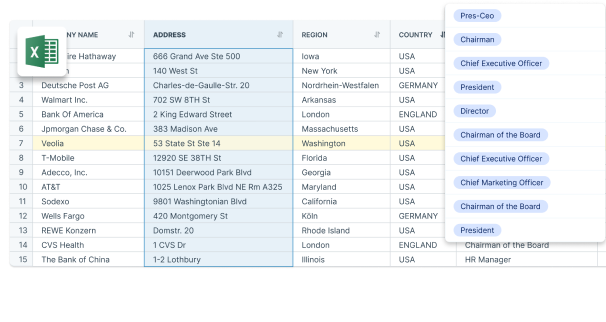Leveraging Social Media Signals for B2B Prospecting and Risk Assessment
Using social media signals for B2B prospecting and risk assessment is changing how companies find opportunities and manage threats. In today’s digital-first world, social media signals—like likes, shares, comments, and mentions—provide instant information about buyer intent, engagement levels, and potential risks related to prospects or partners.
Why it matters:
- B2B prospecting powered by social signals helps teams cut through the noise and focus on accounts showing active interest.
- Risk assessment becomes more dynamic, as public sentiment and digital interactions provide early warning signs of reputational or compliance issues.
CompanyData.com provides the most comprehensive and trustworthy company information in the world to support these efforts. With data on ownership structures, financials, contacts, and more—integrated directly into your workflows—businesses can combine verified company intelligence with live social insights for sharper targeting and better decision-making.
Understanding Social Media Signals in B2B Context
Social media signals are the digital footprints left behind by users and businesses interacting online. In a B2B context, these signals include:
- Likes on company updates or industry news
- Shares of whitepapers, blog posts, or event announcements
- Comments on thought leadership articles or solution demos
- Mentions in conversations, hashtags, or group discussions
Each action reflects a different layer of B2B engagement. For example, repeated likes and shares from a buyer’s team can indicate rising interest in your product category. Comments showing specific pain points or asking detailed questions often signal readiness for deeper conversations. Public mentions—especially from decision makers—highlight active consideration or influence within their organization.
Relying solely on these social media signals can be risky; likes and shares alone don’t guarantee sales intent. The power comes from combining this online behavioral data with hard company facts—such as firmographics, financials, and verified contacts. Integrating these sources creates a more accurate picture of which prospects are both active and qualified. This multi-layered insight helps teams prioritize outreach, personalize messaging, and avoid wasted cycles on low-potential leads.
Using Social Media for B2B Prospecting
Precision matters in B2B prospecting. LinkedIn Sales Navigator stands out as a core tool, letting teams cut through the noise fast. By filtering prospects by industry, seniority, activity level, and company size, sales teams build refined lists that reflect real opportunities. Advanced search features help target decision-makers who are active and engaged—those most likely to respond.
The Advantages of Different Social Media Platforms
Each social media platform offers its own advantages when it comes to B2B prospecting:
- LinkedIn Sales Navigator: Filter by job function, recent activity, and shared connections.
- Twitter Prospecting: Engage in real-time with timely responses to trending industry topics.
- Instagram for B2B: Use visual storytelling to attract interest from forward-thinking brands.
Combining these channels ensures a broader reach across different buyer preferences, while each platform brings unique signals to strengthen prospecting strategies.
How Each Platform Can Help You Connect with Prospects
Here’s how you can leverage each platform to connect with your prospects:
- LinkedIn Sales Navigator: Use this tool to filter prospects based on their job function, recent activity, and shared connections. This will help you identify key decision-makers and tailor your outreach accordingly.
- Twitter Prospecting: Stay updated on industry trends and engage with business leaders by responding to their tweets or joining conversations around relevant topics. This demonstrates your knowledge and establishes rapport.
- Instagram for B2B: Showcase your brand’s personality through visual content on Instagram. Share stories of client success, partnerships, or innovative projects that resonate with your target audience.
By understanding the strengths of each platform and adapting your approach accordingly, you can enhance your B2B prospecting efforts and increase the likelihood of generating meaningful conversations with potential clients.
Utilizing Buyer Intent Data from Social Media Signals
Identifying buyer intent data is about more than tracking surface-level engagement. On social platforms, interactions such as comments, shares, and keyword-driven discussions provide clear signals of where prospects stand in their purchase journey. However, it’s crucial to be aware of the potential for social media surveillance by governments, which can impact user behavior and engagement patterns.
1. Comments and Shares as Indicators
When a lead comments on a post about industry trends or asks questions related to your solution, it shows active research and evaluation—classic signs of sales readiness. Shares carry even more weight: they suggest the content resonated enough for someone to distribute it within their own network, amplifying reach and indicating alignment with your messaging.
2. Content Consumption Patterns
Monitoring which types of content get the most interaction helps teams map the prospect’s interests. For example:
- Frequent sharing of case studies or product comparisons points to an intent to buy.
- Engagement with thought leadership articles may reflect early-stage awareness.
3. Keyword Tracking and Website Visits
Combining social media keyword tracking with website analytics delivers deeper insight. If a target account’s employees are using relevant product or pain-point keywords on LinkedIn while also visiting your pricing page, that’s a double signal—both behavioral and contextual—of high purchase intent.
Effective B2B prospecting hinges on this kind of multi-source approach. Leveraging Social Media Signals for B2B Prospecting and Risk Assessment means not just seeing who interacts, but understanding what those interactions reveal about timing, readiness, and fit. Integrating these insights with verified company data unlocks next-level precision for sales and marketing strategy.
Benefits of Using Social Media Signals in Prospecting and Risk Assessment
Social media signals improve the accuracy of lead qualification. By using real-time interactions—likes, shares, comments—B2B teams can identify prospects who show genuine, active interest in specific products or services. This direct engagement reveals which leads are not just browsing but are actively considering solutions.
1. Improved Lead Qualification Accuracy
Filtering prospects by observable activity means less time wasted on cold leads. When a prospect consistently engages with your content or participates in discussions relevant to your industry, that’s a clear sign they’re moving through the buyer journey. These insights help prioritize outreach efforts for higher conversion rates.
2. Personalized Marketing at Scale
Social media behaviors offer a window into what topics resonate with each account. With this intel, sales and marketing teams can craft messages tailored to specific interests or pain points, boosting engagement. For instance:
- If a decision-maker frequently comments on regulatory compliance posts, direct them to resources addressing those challenges.
- If a company’s team shares success stories about digital transformation, position your solution as an enabler in that narrative.
Personalization built on social data cuts through noise and drives responses.
Conversion rates increase when outreach is both timely and relevant. Integrating social signals into prospecting workflows allows for smarter targeting, more meaningful conversations, and stronger relationships—all critical for B2B sales cycles that often hinge on trust and relevance.
Risk Assessment Through Social Media Analysis
Social media analysis tools, such as those offered by Hootsuite, allow you to directly monitor what people are saying about your potential clients, partners, or even your own business on various online platforms. These tools help identify potential problems before they become major issues.
1. Brand Mentions Reveal Red Flags
Using social media analysis tools, you can track every public mention of a company, executive, or product. A surge in negative comments, complaints about leadership, or news about layoffs can point to instability. If a potential partner is suddenly trending for the wrong reasons, it’s a signal to dig deeper before moving forward. You can even explore some of the easiest ways to monitor brand mentions for free which could be beneficial.
2. Sentiment Tracking for Early Warnings
Gauge the tone of conversations with sentiment analysis. Consistent negative sentiment around a company may signal reputational risk or upcoming compliance problems. For example, ongoing criticism of environmental practices or customer service lapses could indicate trouble ahead.
3. Always-On Monitoring
Continuous analysis means issues surface fast—before official press releases or financial reports. This proactive approach supports due diligence and helps protect your reputation by avoiding associations with companies facing significant public backlash.
Combining real-time social listening with verified company data from sources like CompanyData.com creates a powerful filter for risk assessment. This approach keeps teams alert to shifts in perception and potential threats within their pipeline.
Integrating Social Media Signals with Account-Based Marketing (ABM) Strategies for High-Value Accounts
Aligning ABM strategies with real-time social media signals creates a clear path to personalized campaigns that actually resonate. When targeting high-value accounts, intent data captured from activities like post engagement, company mentions, and content shares provides direct evidence of where the account’s interests lie.
Benefits of Integrating Social Media Signals with ABM Strategies
- Custom Messaging: By monitoring what target accounts comment on or share, sales and marketing teams can craft outreach that references these specific interests or pain points.
- Prioritized Outreach: Accounts showing increased activity—such as frequent engagement with industry topics—move to the top of the prospecting list, enabling focused effort where buying intent is highest.
- Content Tailoring: Social insights reveal trending topics for each account, guiding content creation for email sequences and ad campaigns that address timely needs.
Leveraging Social Media Signals for B2B Prospecting and Risk Assessment within ABM ensures each interaction is relevant, timely, and driven by actual buyer behavior rather than guesswork.
Future Trends in Leveraging Social Media Signals for B2B Lead Scoring and Risk Management
Artificial intelligence is rapidly changing how B2B companies process social media data. The volume of social signals—likes, shares, mentions, and comments—now demands automated systems to sort signal from noise. AI-powered tools analyze patterns at scale, flagging shifts in engagement or sentiment that manual review would miss.
1. Predictive Analytics for Enhanced Lead Scoring and Risk Assessment
Predictive analytics is pushing lead scoring and risk assessment to new levels. Models trained on historical data can identify prospects most likely to convert or partners that may pose compliance risks. With automated lead scoring, sales teams receive prioritized lists based on real-time social activity, intent signals, and firmographic data.
2. Competitive Advantages for Early Adopters
Companies using these technologies gain a competitive edge:
- Faster detection of high-value opportunities
- Proactive risk management through early alerts
- Continuous refinement of qualification criteria as new data flows in
This evolution means B2B teams must keep up with advances in AI and predictive modeling to stay ahead in prospecting and risk assessment.
Conclusion
Leveraging Social Media Signals for B2B Prospecting and Risk Assessment transforms how businesses approach targeted outreach, resource efficiency, and proactive risk mitigation.
- Sharper Targeting: Social signals provide live feedback on prospect engagement and intent, allowing teams to align offers with real buyer needs.
- Resource Optimization: By filtering out low-interest prospects early, sales and marketing can focus energy on accounts most likely to convert.
- Risk Reduction: Ongoing social monitoring surfaces reputational or compliance issues before they escalate.
Integrating these social insights with verified company data from platforms like CompanyData.com ensures every decision is grounded in accuracy. This blend of real-time engagement cues and robust firmographic intelligence enables teams to act fast, personalize interactions, and reduce guesswork at every stage of the B2B cycle.
The result: smarter prospecting, better lead quality, and fewer surprises along the way.

